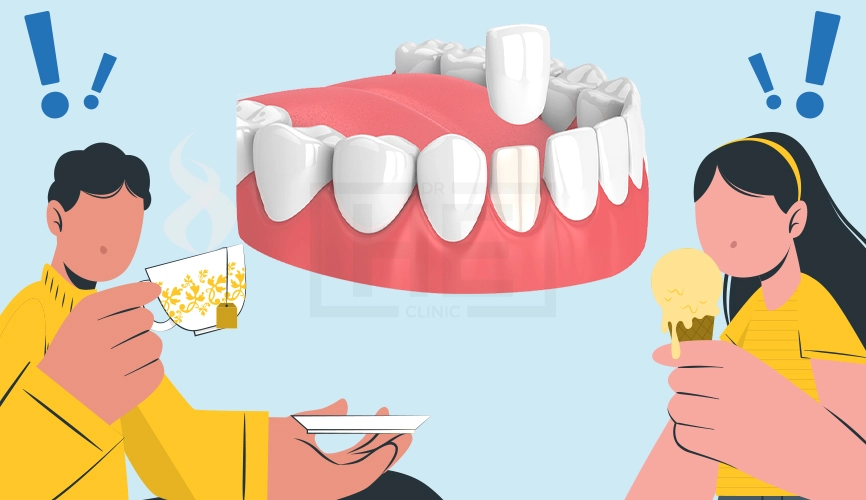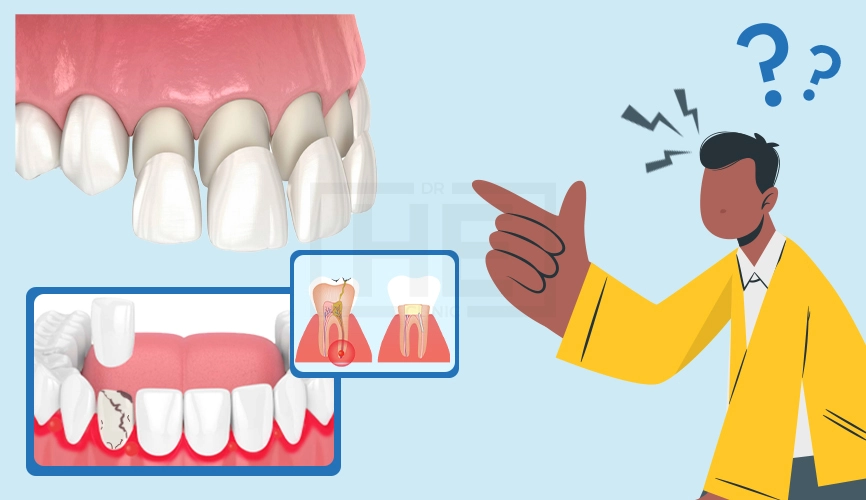Most common veneers side effects
In fact, these side effects can show different effects for everyone. We will still write the entire list of most common veneers side effects. Do not think about the possibility that they are all in the same person. Maybe only 1-2 of them can be seen or not seen at all.
Problems with color matching
In fact, the basis of this problem is due to the lack of materials that we, as dentists, use to make veneers. In order for the materials we use today to reflect the exact color performance, they must be of a certain thickness, which is 1.2 mm. Therefore, the more we cut and shrink a tooth, the thicker the material of the veneer that we will put on it will be, and the desired color will usually be found and the neighboring teeth on the side will adapt. If the veneers have a porcelain-metal mixture content, it is normal for these lines to form. But it is possible to eliminate these aesthetically unpleasant streaks. Possible solutions can be discussed by contacting the dentist.
Sensitivity to heat and cold

This condition usually occurs within a few hours after the operation. As the anesthesia begins to lose its effect, sensitivity may be felt in the tooth. Sensitivity is very common in the period when temporary veneers are used and in the first period after installing permanent veneers. It should not be considered a problem. The problem is the pain that wakes you up from sleep at night. Contact your doctor without wasting time on this situation. Nerve residues inside the tooth that is coated can react to heat and cold. To solve this problem, your dentist may recommend special pastes or toothbrushes designed for sensitive teeth. If pain occurs during biting, even though time has elapsed since the operation, it may be due to placing the crown too high. You can easily solve this problem by contacting your dentist.
Gum tissue inflammation
The most important symptom of the problem in question is bleeding in the gingival margin and bad breath. Gum bleeding, which is usually experienced during brushing your teeth, and the resulting gum sensitivity can be a symptom of gum disease. Swelling and redness of the gums, which causes pain in the gums, is also an important symptom. Eating and drinking problems may arise due to pain, quality of life decreases. One of the most important symptoms of gum problems is the black dots on the bottoms of the teeth that are formed due to dental stones. There are several reasons why there may be an infection under your coat. One of them is that the veneer itself does not quite fit your tooth. If there is a so-called dark stain under it, this may be the result of a micro-leak, that is, bacteria seep through the porcelain Decking and the intermediate phase of your tooth. Micro-leakage eventually causes caries and sensitivity in the nerve of your tooth, and possibly infection. If this is your case, you should immediately see a specialist cosmetic dentist to change the veneer.
Tooth trauma and pulp decay

Tooth trauma is a physical injury to the teeth, gums, alveolar bone, or soft tissue of the mouth, including the lips and tongue. The pulp is the connective tissue through which the nerves and blood vessels located inside the tooth pass. A pulpotomy is the removal of an inflamed part of the pulp and the placement of a medicated medical device in the place where it was removed to prevent toothache. Both side effects may be observed after veneer. But if it is treated instantly, no serious problems will occur.
Placement issues
If the veneer made is not suitable for the tooth, that is, compatible. If the amount of adhesive used in the Decoupage area becomes too thick, loosening may occur. Loosening the veneer allows bacteria to leak through the opening December and can cause tooth decay. If it is felt that the crown is loosening, the dentist should be contacted immediately. The reason should be determined in detail. It may also be necessary to change the veneer being made. The fall of veneers is based on two main reasons. One of them is the decay of the tooth under the veneer or the loosening of the material used during the installation of the crown. In the event that the veneer falls off, it is necessary to thoroughly clean the veneer and the front part of the tooth, then glue it with special adhesives. A dentist should be contacted as soon as possible and the necessary measures should be taken.
Possible tooth decay
There are cases when trauma from bites, such as gnashing teeth or squeezing teeth, can also cause infection under the veneers, in these cases, you do not need to change the veneers, because there are no gaps, and the Endodontist can do the root canal treatment from this point on. There is no need to replace the back of the infected tooth and porcelain veneers. A warning if root canal treatment is to be performed on a tooth coated tooth: because there is no nerve or blood supply in the tooth, the tooth may darken after a few years, and it may also become brittle.
Allergic reaction to anesthetic
Although the new generation veneers are no longer made entirely of metal, a mixture containing various metals can be used. In rare cases, it may happen that some patients have an allergic reaction to these metals. In some cases, there may be problems with allergy to anesthesia. There are early and late signs of an allergy reaction. Symptoms that recur in a short time increase rapidly and can complicate the general state of health. For this reason, the patient and the physician should be alert to the allergy problems that can be seen in the dental veneer materials. At early signs it is easier to understand that the problem is caused by the tooth veneer. Shortly after the tooth is inserted, burning in the mouth, redness and swelling appear in areas close to the material. Redness and itching may also occur in other body parts. The installed veneer should be removed as soon as possible.

